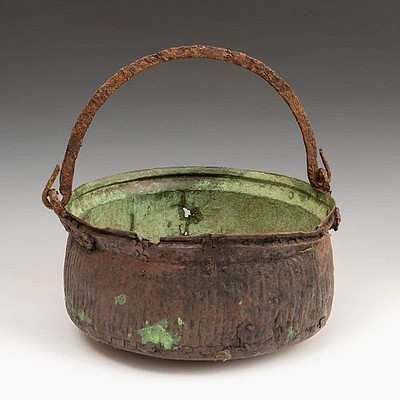Infant's head. Greece Attica, IV century BC. Marble. Provenance: Private collection A. A., Vienna, Austria. Measures: 20 cm (height).
Lot 84
About Seller
Setdart Auction House
Carrer Aragó 346
Barcelona
Spain
Setdart Subastas was born in 2004 and is currently the first online art auction in Spain with solidity, prestige and reliability guaranteed by our more than 60,000 users. Setdart has a young, dynamic and enterprising team ready to successfully manage the purchase and sale of art works through custom...Read more
Estimate:
EUR€10,000 - EUR€12,000
$10,752.69 - $12,903.23
Absentee vs Live bid
Two ways to bid:
- Leave a max absentee bid and the platform will bid on your behalf up to your maximum bid during the live auction.
- Bid live during the auction and your bids will be submitted real-time to the auctioneer.
Bid Increments
| Price | Bid Increment |
|---|---|
| EUR€0 | EUR€10 |
| EUR€200 | EUR€25 |
| EUR€500 | EUR€50 |
| EUR€1,000 | EUR€100 |
| EUR€3,000 | EUR€200 |
| EUR€5,000 | EUR€500 |
| EUR€10,000 | EUR€1,000 |
| EUR€20,000 | EUR€2,000 |
| EUR€50,000 | EUR€5,000 |
About Auction
By Setdart Auction House
Dec 22, 2021
Set Reminder
2021-12-22 08:30:00
2021-12-22 08:30:00
America/New_York
Bidsquare
Bidsquare : Archaeology, Session I
https://www.bidsquare.com/auctions/setdart-auction-house/archaeology-session-i-8050
Setdart Auction House sofia@setdart.com
Setdart Auction House sofia@setdart.com
- Lot Description
Infant's head. Greece Attica, IV century BC. Marble. Provenance: Private collection A. A., Vienna, Austria. Measures: 20 cm (height). Head belonging to a complete and worked round sculpture of a girl. A clearly childish face, with bulging cheeks and delicate features, is decorated only by a ribbon that gathers the curly hair as wavy locks. The most direct parallel of this piece, both for its size and its peculiar style, are the sculptures of girls found in the Temple of Artemis of Brauron, today preserved in its archaeological museum. Brauron was one of the twelve cities that the mythical king Cecrope established in Attica and that were later united by Theseus in the city of Athens. According to legend, Iphigenia left in the sanctuary of Brauron, where she came to serve as priestess, the wooden statue of Artemis that she had brought from Thaurica. According to a local tradition, it was in Brauron that Iphigenia was to be sacrificed but before that she was replaced by a bear or a bull by Artemis. It was a city famous for its sanctuary dedicated to the goddess Artemis, founded in the ninth or eighth century BC, excavations revealed places of worship as a cavern; the tomb of Iphigenia, with an aspect of a grotto, next to it a small shrine, a heroon where Iphigenia was worshiped by receiving as an offering the clothes of women who died during childbirth. Other buildings of the sanctuary were a temple, a parthenon, a gymnasium, an amphipoleion (dwelling of the priests), a palestra, stables and an important sacred spring. Later, in the 3rd century B.C., the Erasinos river covered it completely, allowing its preservation, since it was located at its mouth. One of the most interesting discoveries of the cult of Artemis Brauronia is that it was dedicated to women. The maiden goddess Artemis protected newborns and young women during childbirth, the most important time of their lives, as mortality rates from childbirth were quite high for both babies and mothers. The largest building in the sanctuary was the "stoa of the Arktoi" or "bear room", it had a total of nine rooms and each room housed eleven wooden beds and seven tables. It has been suggested that the function was as a dormitory for the girls or perhaps as a refectory where collective banquets were held. Numerous statues of girls and boys have been found in front of the rooms, dating from the second half of the fourth century BC, indicating that at this time Artemis appears mainly as a goddess of work and protector of children. Some details of the rites and festivities that were celebrated in the sanctuary are known from some literary sources and also from representations found on pottery as well as on the preserved marble relief friezes. The girls between 5 and 10 years old spent some time in the sanctuary of Brauron, they exercised in the dance, in the pedestrian race and in the art of weaving, in order to be better prepared for their adult life, thus, besides a religious center it was a place of education.
- Shipping Info
-
In-house shipping available. Please inquire at admin@setdart.com.
-
- Buyer's Premium



 EUR
EUR CAD
CAD AUD
AUD GBP
GBP MXN
MXN HKD
HKD CNY
CNY MYR
MYR SEK
SEK SGD
SGD CHF
CHF THB
THB















